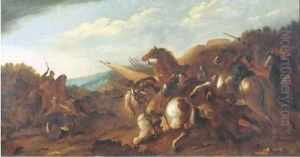Andrea De Lione Paintings
Andrea De Lione was an Italian painter of the Baroque period, born in 1610 in Naples. He is known for his vibrant compositions, which often depicted historical and mythological scenes, as well as religious subjects. His style was heavily influenced by the dramatic naturalism of Caravaggio and the Neapolitan school of painting, which was prominent during his time.
De Lione began his artistic career under the guidance of his brother, Giovanni Bernardino Azzolino, who was also a painter. However, Andrea's talent soon outshone that of his brother, and he became a pupil of Massimo Stanzione, an important painter in Naples during the early 17th century. Through Stanzione, De Lione was exposed to the works of Caravaggio, which would have a lasting impact on his use of chiaroscuro and the stark emotional intensity of his figures.
In addition to his paintings, De Lione was also known for his skill in creating frescoes, a popular medium for public and religious art during the Baroque era. His work was characterized by its dynamic compositions and his ability to convey movement and emotion in his figures. He was also noted for his adept use of color, which added depth and vibrancy to his scenes.
During his lifetime, De Lione received commissions from many prestigious clients, including religious institutions, nobility, and private collectors. His works were particularly sought after for their ability to evoke the spiritual fervor and drama that were favored by the Counter-Reformation church, which sought to use art as a means of religious persuasion and reaffirmation of faith.
Andrea De Lione's contributions to the world of Baroque art in Naples were significant, and his works are considered an important part of the artistic heritage of the period. He died in 1685, leaving behind a legacy of influential paintings that continue to be studied and admired for their emotional power and technical skill.
